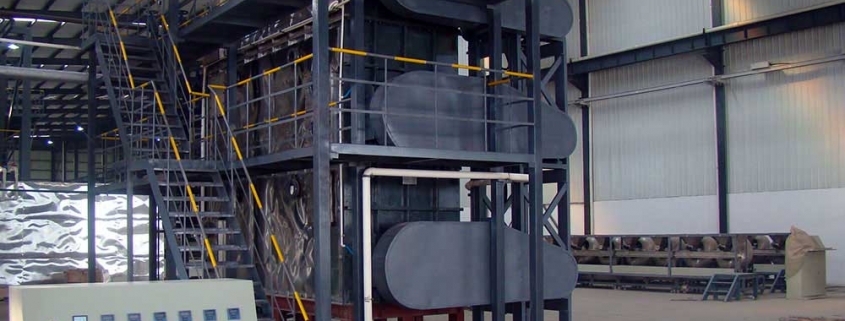The paddle dryer uses the agitation of the internal blades of the equipment to complete the drying of the material. In many industries that require drying, the paddle dryer can be seen. What are the applications of the paddle dryer? How to improve the paddle drying? What is the efficiency of the machine?
First, the characteristics of the paddle dryer
1, small footprint
The device is compact in structure and has a small footprint. It can be seen from the structure of the device that the heat required for drying is mainly provided by the hollow blade wall surface arranged on the hollow shaft, and the heat transfer amount of the jacket wall surface is only a small part. Therefore, the heat transfer surface of the unit volume equipment is large, which can save equipment footprint and reduce capital investment.
2, high heat utilization rate
Typical conduction drying method, energy saving, large conduction coefficient, high thermal efficiency; paddle dryer is heated by conduction heating, all heat transfer surfaces are covered by materials, reducing heat loss; no hot air takes away heat, heat utilization can be It is more than 90%; the stirring blade is also a heat transfer surface, which increases the heat transfer area per unit effective volume and shortens the processing time.
3, self-cleaning ability
The wedge-shaped blades have self-cleaning ability to improve the heat transfer of the blades. The blades rotate in opposite directions, and the two inclined surfaces of the blade repeatedly stir, compress, relax and propel the material, so that the page has a unique self-cleaning ability, the heating surface is continuously updated, and the heat transfer coefficient of the paddle dryer is higher than any other conduction. Drying method.
Second, what are the application areas of paddle dryers?
1. Petrochemical industry
Polyolefin powder, polycarbonate resin, high and low density polyethylene, linear low density polyethylene, polyacetal granules, nylon 6, nylon 66, nylon 12, acetate, polyphenylene sulfide, propylene based resin, Engineering plastics, polyvinyl chloride, polyvinyl alcohol, polystyrene, polypropylene, polyester, polyoxymethylene, styrene ~ acrylonitrile copolymerization, ethylene ~ propylene copolymerization.
2. Environmental protection industry
PTA sludge, electroplating sewage sludge, boiler soot, pharmaceutical factory waste, sugar factory waste, MSG factory waste, coal ash.
3. Feed industry
Soy sauce residue, bone-based feed, distiller’s grains, food scraps, apple pomace, orange peel, soybean meal, chicken bone feed, fish meal, feed additives, bio-sludge.
4. Food industry
The uniformity of temperature, humidity, and mixing in the axial section allows the equipment to be used to heat or melt, or to react with some solid materials. It has been successfully used in the compound fertilizer and modified starch industries. The paddle dryer can be used to sterilize food and flour, and the heating area in the effective volume of the unit is quickly heated to the sterilization temperature to avoid changing the quality of the material by heating for a long time. There are also starch, cocoa beans, corn kernels, salt, modified starch, and pharmaceuticals.
5. Chemical industry
Soda ash, NPK compound fertilizer, kaolin, bentonite, white carbon black, carbon black, phosphogypsum, oxidized sodium fluoride, calcium nitrate, magnesium carbonate, sodium cyanide, aluminum hydroxide, barium sulfate, calcium sulfate, calcium carbonate, Dyes, molecular sieves, saponins.
The heat transfer oil is used as the heat medium, and the paddle dryer can complete the low temperature calcination work. For example, calcium sulfate dihydrate (Ca2SO4•2H2O) is calcined and converted into calcium sulfate hemihydrate (Ca2SO4•1/2H2O). Sodium hydrogencarbonate (NaHCO3) is converted into soda ash (Na2CO3) by calcination.
Cooling medium such as water, cooled brine, etc. can be used for cooling. For example, the paddle type caustic soda machine used in the pure soda ash industry replaces the old-fashioned air-cooled alkali-alkali machine, saves the energy and quantity of materials and exhaust gas disposal equipment, reduces the operating cost, and can also be used for titanium, nickel-iron alloy powder and Cooling of various powdery materials. The material can be cooled from 1000 ° C to less than 40 ° C in a single machine.
Second, how to improve the efficiency of the paddle dryer?
1. When the paddle dryer is working, pay attention to the smoothness of the material feeding when the material is put into the material. The material and the like contain a lot of water, which is easy to bond together. If it is bonded together during the blanking, the material will block in blocks. The silo, this will cause the material to not fall down, can not enter the equipment, can not dry.
2. Humidity control during feeding, the humidity of different materials is different, some are high and some are low. When drying materials, the humidity of the slime needs to be checked, and then the materials are placed according to the corresponding standards.
3. The amount of the problem needs to be considered in the feeding of the dryer. First, whether the uniformity of material delivery is up to standard, try to avoid such fluctuations in feeding mode, and secondly, consider the drying capacity of the dryer – capacity problem, if the progress of the material is far beyond the dryer If you work, the drying work will not be completed.
4. Before entering the equipment, confirm whether dehydration treatment is needed. Some materials have too high water content and are directly dried on the machine. Not only is the time long and the efficiency is slow, the cost is greatly increased, and the drying effect is not necessarily ideal. So for this case, early dehydration is a good treatment.
5, the premise of good operation of the equipment is that there is no fault, regular inspection is to eliminate hidden dangers. In order to avoid problems and get stuck in the work, you can find the problem and solve the problem in time.
The periodic inspection of the paddle dryer is due to the special nature of the equipment, and a comprehensive technical assessment work must be carried out by the state. The inspection must be carried out by the department that has obtained the inspection qualification.
Through the inspection, the actual safety status of the paddle dryer is better grasped, and the importance of the use and management of the equipment by each user unit is improved. By testing and detecting hidden dangers, the inspection report and the rectification notice were immediately issued, which greatly improved the rectification rate and achieved good results.
Regular inspection of the paddle dryer is an important part of the equipment maintenance work, so as to master the equipment operation, work performance and wear. Prepare for repair work, improve repair quality and reduce repair time. The contents of the inspection included understanding the changes in the technical status of the paddle dryer and the wear and tear; the problems found. Propose measures for equipment repair work.


